Sat 31 Oct – Fri 6 Nov 2009 Raxual to Kushinagar to Lucknow
After crossing the border the first town we hit was Raxual in the state of Bihar. Raxual was the usual dusty border town and Bihar is infamous for being a crime capital of India - it is very poor and ongoing battles run between the Naxalites - various local communist groups - and the police with the local people getting caught in the middle. We had heard stories from other overlanders of groups of men with sticks surrounding them to demand money in Bihar so we weren't keen to linger here long. Thus when only a few kms down the road the brakes refused to release so we couldn't move we weren't best pleased! To cut a long story short we ended up staying at a delightful (NOT!!) little town called Motihari. Bihar is definitely the staring capital of India and everywhere we went we were followed by a circle of starers. Every time we came to a stop at least 10 or so people formed a queue within seconds to stare at us. As you can imagine this was a little wearing! We did try to find a hotel room but the 2 we went in were incredibly filthy and grotty and we headed straight out again. Thankfully we did meet a kind proprietor of a local petrol station and he let us camp at the back of his building. We got up very early to beat the starers and headed across the road to find a mechanic.
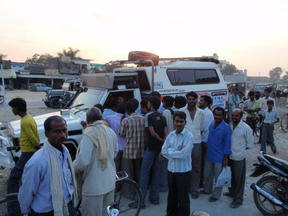
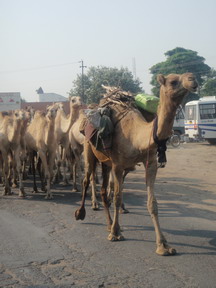
They quickly got to the root of the problem - there was a nail in our brake line!!!! Apparently this is something done by amateur mechanics to increase the height of the pedal thus making it seem that the brakes are working well which was what Andrew took the car to Toyota to check. You really would expect more from Toyota it must have been done there as no one else has been near our brake lines. Not happy!!!! We'll have words with them back in Kathmandu.
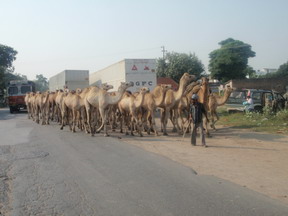
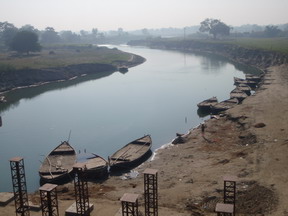
In the meantime thankfully we were back on the road and we high tailed it out of Bihar without any more dramas. By this time we had reluctantly but realistically come to the conclusion that we weren't going to make the Pushkar camel fair. We still had nearly 2000 kms to go and were pretty tired after a poor night's sleep. Obviously not meant to be but we'll see plenty of camels once we hit Rajasthan! We also had a sort of taste of the camel fair when we saw several large herds (around 200) of camels with a couple of handlers heading up the freeway. They were coming back from the sales at Pushkar having purchased these camels - so we got to at least see the aftermath of the fair!
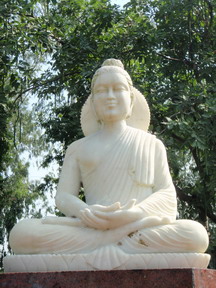
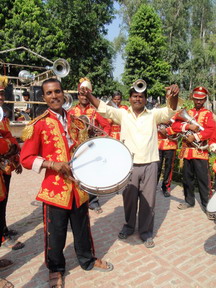
So after a hairy start to our time back in India on Sunday 1 November we were relieved to arrive at Kushinagar - a lovely peaceful little town and just what we needed! Kushinagar (which means place of happiness) is where Buddha died and like Lumbini his birth place we visited in Nepal it is a place of great pilgrimage. We were lucky enough to find a great place to camp at Pathik Niwas a UP Tourism hotel.
They had a spacious front garden (complete with Buddha statue) and a really good restaurant. Before we went there though we had a problem as due to the car trouble we had no cash left. We drove 18 km to reach the nearest ATM - only to find it was shut. No problem - the security guard phoned the bank manager who came down on Sunday afternoon and it was opened just for us and shut again!! As we've said before India is amazingly welcoming. This often happens to us - we are queuing and are ushered to the front "please you are our guest." This is sometimes quite embarrassing but very kind. It doesn't really happen at home -can you imagine if an Indian tourist was ushered to the front of a long queue where everyone was waiting to use the ATM - there'd be a riot!
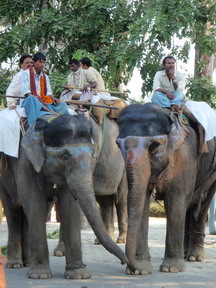
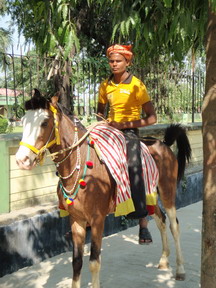
Anyway with money out we headed back to our hotel garden and a reasonably quiet night's sleep. We hadn't realized but the full moon was upon us and this is a very important time for Buddhists. As Buddhist was originally a Hindu and many Hindus believe him to have been a reincarnation of one of their gods they also get involved in the celebrations. This meant that there was a lot of temple music late into the night and pilgrims arriving by the coach load all through the night for the next day's celebrations.
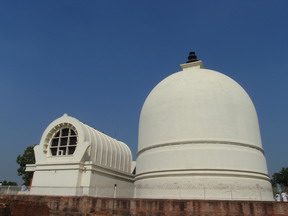
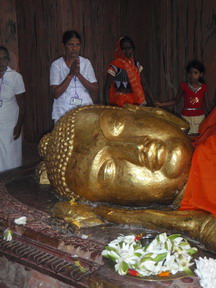
The next morning it was all happening. There was a procession down the main street with dressed up elephants gorgeous horses a band and a phenomenal number of school kids (who seemed to have a police escort to keep them in line!) All in all it was very interesting. We met a guide a Mr. Birendra Mishra who showed us around the Mahaparinirvana Temple - speaking very good English as well as Japanese he was a good guide and we'd recommend him if you're in the area. He can be contacted on 9839586412.
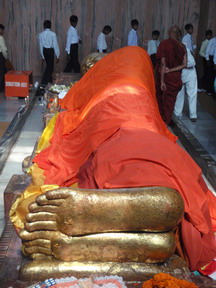
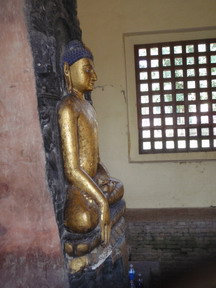
The temple is set in beautiful gardens where Buddha having uttered the words "All things must pass. Work out your own salvation with diligence" died at the age of 85. It also houses an impressive 6 metre long reclining Buddha dating from the 5th century it was rediscovered and renovated in 1876.
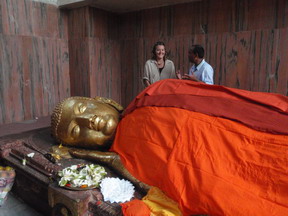
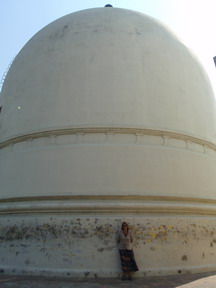
Behind the temple is a 19 metre white stupa said to house Buddha's ashes. Much like Lumbini the entire area is one of pilgrimage for Buddhists from all everywhere and many have built their temples here so there are temples representing Buddhist communities from all over the world.
We visited a Burmese and a Thai temple both of which really took us back to being in those respective countries. The Thai one was full of pictures of the King and other Royal family which REALLY reminded us of Thailand!
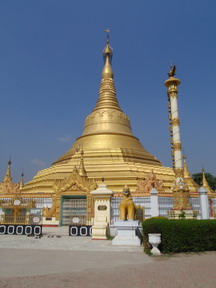
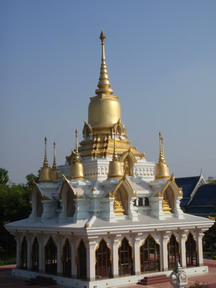
On our way back after seeing this we crossed into a little (Hindu) temple and stumbled across a wedding. It is currently wedding season and you can see and hear them everywhere. We were made very welcome and invited to sit and eat a picnic in the temple grounds with the wedding guests. It was obviously a poor wedding - the people were from a small village and had all come by truck. We watched the veiled bride be lead around the sacred fire by her husband and then lead him around after which they were pronounced man and wife. It was weird to think that that day was the first they had ever seen each other. She will now leave her home and family to live with him and his. No wonder the poor girl looks a bit apprehensive! As there were no cameras in evidence we took a few snaps to send to them so they'll have a record of their big day. Very interesting and very different for us Westerners!

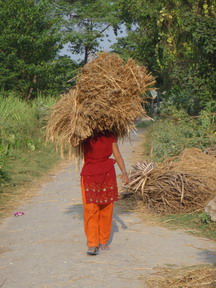
Taking a walk out into the countryside we first passed a small temple - the Mathakuar Temple - which houses an ancient Buddha statue. It was a pleasant sunny afternoon and we walked past a real rural scene - people getting the rice crop in , buffaloes wallowing and butterflies everywhere all very pleasant before we arrived at the Ramabhar Stupa. This huge 15 metre high structure is said to be built on the exact spot where Buddha was cremated.

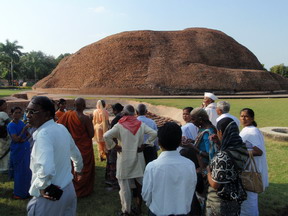
All in all we spent a lovely couple of days in Kushinagar relaxing enjoying the sunshine and chilling out. We also got to watch Australia play India in the cricket which packed huge crowds around any TV whenever it happened. They were very good natured when we won thankfully!! Now that the time pressure to reach Rajasthan (and especially Pushkar) has abated we can afford a few detours and so we decided to head next for the historical town of Lucknow.
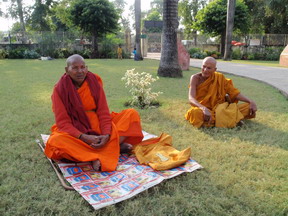
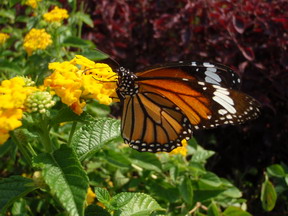
Sugar cane is the majority crop around here (together with rice) and on the way we passed quite a few cottage industry sugar refineries and at one we stopped to take some pictures. The cane was cut and shoved through a hole into a press where the juice was extracted - this was then boiled up and hand rolled into sweets to sell. We've tried a few Indian sweets as they are very popular here and quite delicious and it was interesting to see them being made. As ever in India the process was very labour intensive.
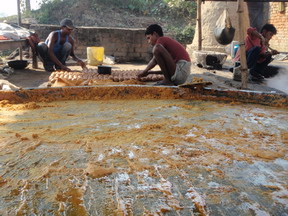
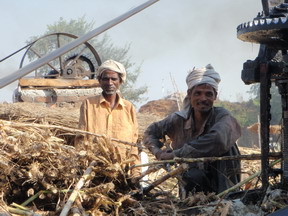
We stopped briefly for lunch at Faizabad where we got a bit lost and had to drive through a network of narrow streets to relocate the highway! We've left Buddhism behind the area now seems to be predominantly Muslim.
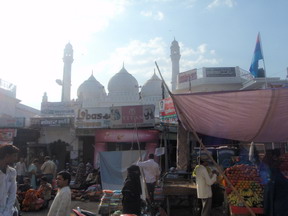
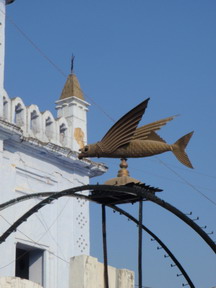
Lucknow is a town with a real sense of history. It rose to importance as the home of the Nawabs or Kings of Avadh and most of the monuments date from this period (late 18th and 19th centuries) their Royal symbol was 2 fishes and fish are represented in carvings and statues all over the city. It was also in 1857 the scene of the siege of Lucknow so all in all there is quite a lot of interest to see.
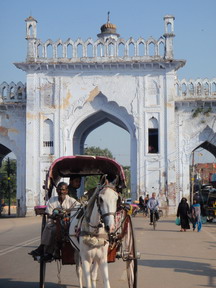
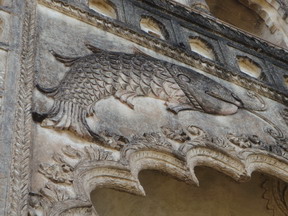
Whilst very interesting and a surprisingly sophisticated city Lucknow was really no place for overlanders. It was impossible to get parking and we tried in vain. Security in India has tightened after the Mumbai bombings and now as a foreigner you have to give passport details whenever you stay anywhere and these are provided to the local police.
The hotels we approached re: parking used this fact as an excuse to say we couldn't camp. The fact that we had registered in this way in hotels all over India and slept in the gardens fell on deaf ears. We thought we'd had success when we approached a security guard at a function centre of some sort (it was empty) and he allowed us to park but his boss appeared and very rudely ordered us off the premises so that was the end of that! We eventually stayed in the Hotel Gomti - a UP Tourism hotel - (which surprisingly didn't know the location of the Tourist office or have a map of the city!) for 2 nights in a fairly dirty budget room. For the third night they had a wedding party which took all the budget rooms so we were turfed out as we couldn't afford the jump up in price for the next level of room - 1700 rupees ($42.50 Aus) from 600 ($15 Aus) for a night and we were stuck until eventually after asking the police we camped near the airport. We were very tired when we finally turned in. The army came over to investigate but thankfully when we showed ourselves they left us to sleep. All in all though not an easy place for overlanders -either get accommodation or give it a miss!
Other than the above we actually did enjoy our time in Lucknow. We ate at the aptly named Nawabs restaurant. The Nawabs were renowned for their cuisine. They were Shiite Muslims and it was typical rich Muslim fare a bit like Kashmir lots of quite creamy spicy meat dishes. We enjoyed spicy lamb curry and Lucknow Aloo - a tomato based potato dish. Nawabs is decorated with pictures of the 10 Nawab Kings and we weren't surprised after the delicious rich food to see that a few of them were somewhat porky!
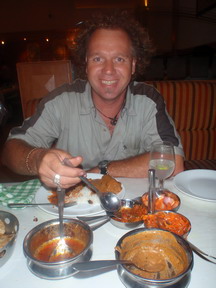
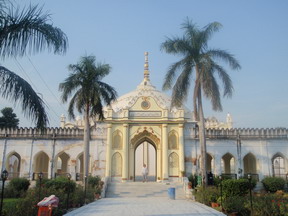
Many of the monuments were being renovated and we looked around one the Imambara (or tomb) of Shah Najaf built by the first Nawab King Ghaziuddin Haider. The interior seemed to be full of ornate lights (from Belgian and China allegedly) and Tazias which are replicas of Imam Husseins' tomb in Iraq. These are paraded around on a special Shiite Muslim mourning ceremony called Muharram. There were little signs in English and little information but that was the basic gist of it!
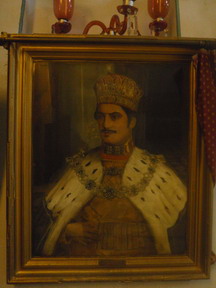
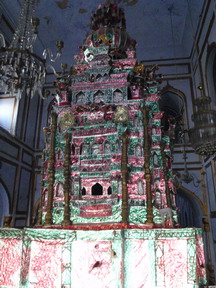
We also visited the Bara Imambara. A huge tomb complex with courtyards and beautiful gates this also had a mosque though this was closed to non- muslims. It was built in the 1780s by Nawab Asaf ud Daula. He his wife and the architect are all buried here. He also built the nearby imposing Rumi Darwaza entrance gate supposedly a copy of one in Istanbul.
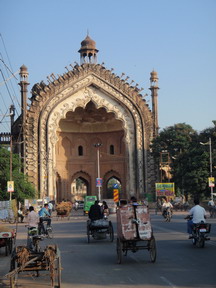
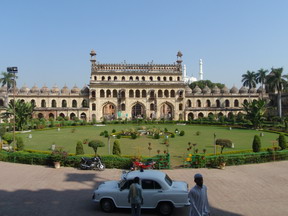
In the Imambara the central hall and gallery were full of Tazias and outside there was a stairway leading to the Labyrinth. This was quite amazing, an interconnecting web of pathways - some of which are dummies some lead to the way out - which was apparently for ventilation. The acoustics were amazing you could whisper down one end and hear it a long way away. Great for hide and seek!
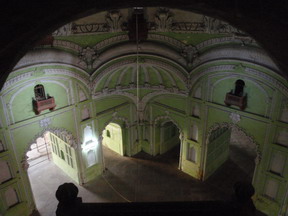
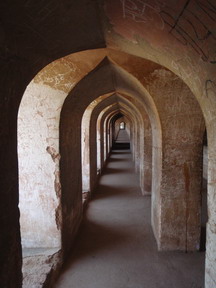
Just down the road we visited Hussainabad Imambara - another tomb built by Mohammed Ali Shah in 1832. He is buried here along with his mother. The tomb is set in a lovely garden setting and has 2 replicas of the Taj Mahal where his daughter and her husband are buried. Again chandeliers and Tazias abound!
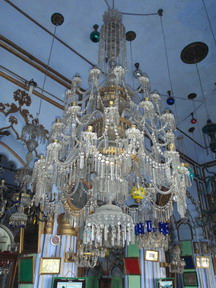
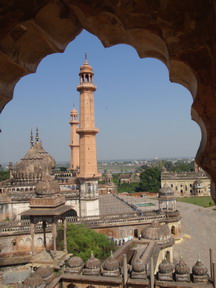
Nearby is an old watchtower and a 67 metre clock tower from the 1880s (supposedly the highest in India) and a picture gallery. This had good pictures of all 10 Nawab Kings but sadly no photos were allowed. The final King - Wajid Ali Shah - was packed off to Calcutta by the British in 1856 to live in comfort but with no power for the rest of his life. His reputation is either as a gourmet and patron of the arts (Indian) or as a fop fortune waster & glutton (British) His picture alone tends to support the British view - he was hugely fat with a fancy hair do and a very ornate outfit - but sadly we have no photographic evidence of this!
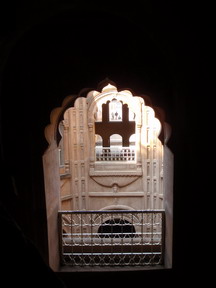
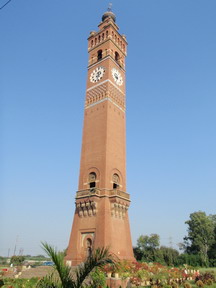
This deposing of their King was one factor which added fuel to the fires of the uprising against the British in 1857 which in turn caused the siege of Lucknow. This happened when all the British residents of Lucknow men women and children had to take refuge with the Governor Sir Henry Lawrence in his Residency. This was actually a complex of a church a mosque a post office a school and various houses and it had no real wall around it so the terrified residents were under attack day and night for the 147 days it lasted. I read an account of the siege written by a Lady James P Harris who along with her husband (the resident minister) survived. Her diary shows a very stiff upper lip being maintained through gunfire ""poor Charlie Dashwood has had both legs taken off by a round shot" terrible hardship, illness and disease especially cholera.
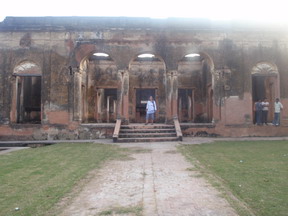
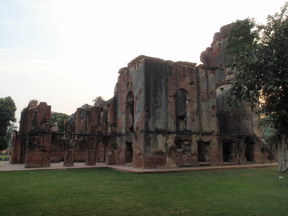
We had a look around the buildings which were just ruins absolutely riddled with shot holes. I am sure JG Farrell must have based his book "The Siege of Krishnapur" on this but can't find any hard evidence to support this. Looked at through 20th century eyes we know colonialism was wrong and if they hadn't all been there bossing people around in their own country it wouldn't have happened but you do feel real sympathy with these people caught up in what was a living hell never knowing when the enemy might swoop in and finish them all off. This never happened and those that didn't succumb to illness or gun shot limped through to tell the tale.
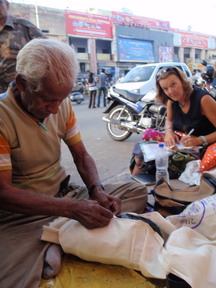
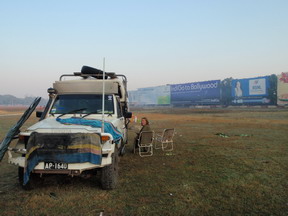
Lucknow as we said is a large city and it had a huge post office. Thus we took the opportunity to send off our Xmas presents. Sending parcels is always good fun in India - you go first to have the contents inspected (don't wrap them first - learn by our mistakes!) then you are sent out to a parcel man who sews them up in calico and stamps them with sealing wax using a special initialed seal. Only then can you think about approaching the counter to begin filling out the various forms in duplicate. Our parcel man took the whole thing very seriously. Trying to organize what was what for our 8 nephews and nieces I got one in the wrong pile and asked for it to be included after the event. You'd think I'd tried to murder him - he went on in rapid Hindu for about 20 minutes about the stupidity of foreigners who did such a thing! We sent it separately - it was easier!! We were a bit of a circus - Andrew wrapping at one end me writing addresses in the middle and him sewing with a huge crowd of gawkers watching it all happen! The whole process took about 2 hours. Hopefully after all that they arrive safely!!
Whilst we enjoyed Lucknow by Friday 6 November after all our parking issues and a so - so night's sleep next to the airport we were ready to head on to our next destination the town of Agra - and the world's greatest architectural master piece the Taj Mahal.
